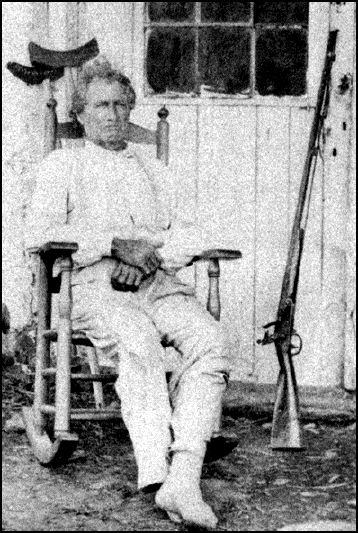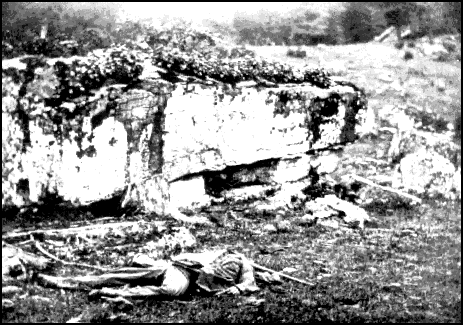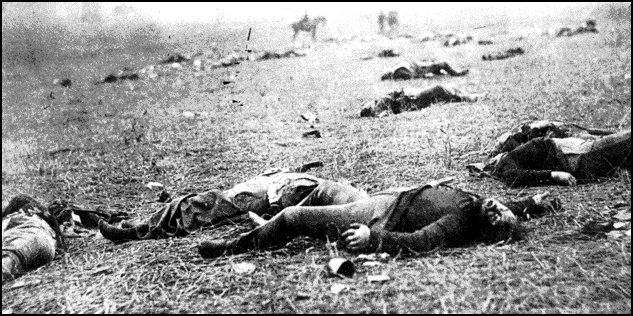Battlefield
The Definitive
Illustrated History
David J. Eicher, Editor
(Chronicle Books)

The most interesting battle was given at Gettysburg. Gettysburg has since been turned into a Theme Park and Civil War fans come to visit dressed up in "Yankee" and "Rebel" uniforms. Using genuine modern antique bayonets, muskets, and cannon balls, they battle it out with each other. Afterwards, they sicken with cholera, gangrene, and the pox, and die like flies.
The cast of characters involved in the war came from the worst of cheap melodrama. One writer, while reviewing A Photographic Picture of the Civil War, stated:
[It] made a hero out of one who should be considered one of the most misdirected, moody rapscallions in American history --- Abraham Lincoln. And historians have unjustly vilified one who was the most noble and self-effacing, namely Jefferson Davis.
He was not, in point of fact, a man of any great competence, even as a soldier. All the major strategy of the war, including the final advance on Richmond, was planned by other men, notably Sherman. He was a ham as a tactician, and habitually wasted his men. He was even a poor judge of other generals, as witness his admiration for Sheridan and his almost unbelievable underrating of Thomas and Meade. If he won battles, it was because he had the larger battalions, and favored the primitive device of heaving them into action, callously, relentlessly, cruelly, appallingly.
Mencken concludes:
Thinking was always painful to Grant, and so he never did any of it if he could help it. He had a vague distaste for war, and dreamed somewhat boozily of a day when it would be no more. But that distaste never stayed his slaughters; it only made him keep away from the wounded. He had no coherent ideas on any subject, and changed his so-called opinions overnight, and for no reason at all. He entered the war simply because he needed a job, and fought his way through it without any apparent belief in its purposes. His wife was a slaveholder to the end.
The original ideal, ostensibly to keep the country united, was a fallacious one. The war put an end to a sectional evolution that could have been immensely beneficial to the future, tolerance, and the ease of America: that is, the division of the country into the northern and southern tier of states.
Had this been allowed to happen naturally, the continent would ultimately have come to be divided into several more appropriately- Since smaller nation-states are uniformly more efficient, more encouraging of civil liberties, less subject to the inefficiency of grandiosity, we would have ended up with six or seven nations which would have grown independent politically --- but which would have been nicely married in language and commerce, and, perhaps, war-making. Best of all, instead of bedeviling the rest of us, the Bush family would have ended up with but one small territory --- the Republic of Texas --- to rule.

One thing we notice about the romanticisers of the Civil War. They pay little or no attention to the psychological, emotional, and human desecration that resulted from its pursuit. Call up its images on any search-engine, and there you'll find maps, and a scattering of blurry photographs, and shots of the leaders: tintypes of Gouverneur K. Warren, George E. Pickett, Robert E. Lee, George C. Meade. But there are few photos of the real carnage --- no hint of the 50,000 men who were killed, wounded, and listed as "missing."Imagine so many thousands of souls sent to meet their maker in the course of a mere three days. And no matter the gloss put on it by Lincoln's drab little no mea culpa speech, it was pure butchery at its worst --- a dry run for the blood-letting that was to envelop the twentieth century.
If you want the real picture, bones and all, you'll find them here in this magnificent volume. There are over three hundred photographs --- ancient and modern --- along with portraits, maps, and thoughtful commentary by fifteen historians. The most fascinating photographs are those of the carnage: scattered shells and clothes, dead horses, broken cannons in the mud, overturned carriages, fallen trees, and everywhere bodies and parts of bodies, twisted and turned and eviscerated, peering blankly, swelling open-mouthed, turning black in the sun. The photographers were there bravely taking pictures only a few days after the battle. One can imagine the raw stench and the wonder that so many were sacrificed for such a puny cause.
The romantic words are now a part of our vocabulary: Cemetery Hill, Plum Run, Devil's Den, Granite Farm, Rose Woods, Valley of Death, Slaughter Pen. The photographs of the surrounding countryside in the grainy shots are here gently mirrored by those taken a century-and-a-half later. Black-and-
white vs. color, muddy roads vs. asphalt highways, body-strewn fields vs. flowering, treed hills. Gettysburg Battlefield is a monumental book in all senses of the word ... one of the most unflinching in showing the dreadful harvest on these bitter fields.
